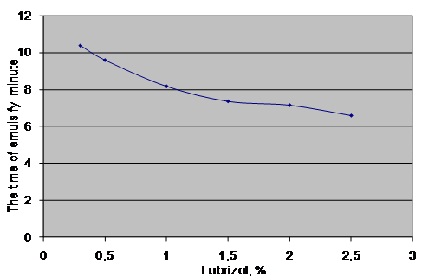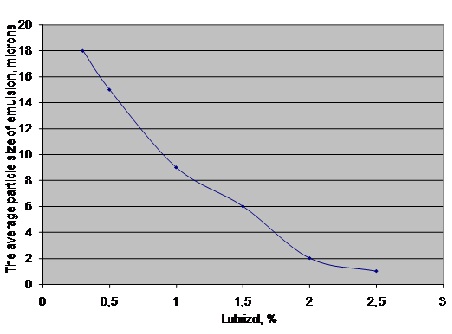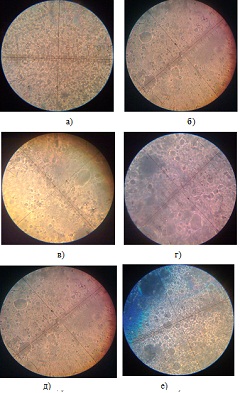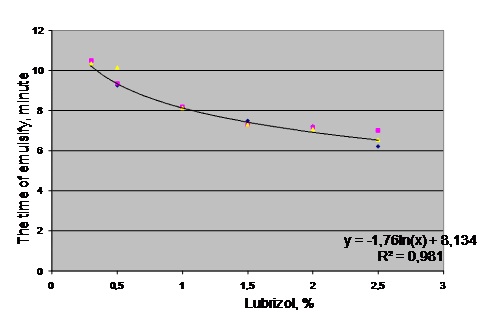Abstract
Content
- Introduction
- 1. Theme urgency
- 2. Goal and tasks of the research
- 3. The object of the research
- 4. Novelty of work
- 5. The practical importance of results
- 6. Experimental part
- 6.1 Experiment
- 6.2 Correlation analysis
- 7. Existing results
- Literature
Introduction
In the early of 1990s Ukraine had developed industries such as mining, coal, aggregates, iron and steel. Every year 240–260 tonnes of industrial explosives had used annually. However, due to the significant, especially over the past 15 years, the decline in coal production and mining industries, the volume of blasting works fell sharply. In 1998 we used only 145 tonness of explosives. However, statistics shows that Ukraine, as before, ranks second in Europe for using explosives. At the same time almost the entire volume of blasting in Ukraine is carried out using explosives containing trinitrotoluol [1]. For the conduct of blasting this explosives are prohibited almost everywhere due to the toxicity of both the trinitrotoluol and its detonation products (NOx, CO).
For implementation of emulsion explosives Ukraine lags behind most of the CIS countries – such as Russia, Uzbekistan, Kazakhstan, Kyrgyzstan [2]. Thus, the inhabitants of mining regions of Ukraine continue to have an additional environmental burden. Today there is a need to create environmentally friendly explosives with low sensitivity to mechanical stress. These may be emulsion explosive.
Advantages of emulsion explosives over the explosives containing trinitrotoluol are:
- Emulsion explosives emit ten times less the gas NOx, CO.
- They are waterproof, which completely eliminates the contamination of groundwater.
- The low sensitivity of the emulsion explosives.
- The relatively low cost.
1. Theme urgency
Production of explosives based on the emulsion matrix directly in mining enterprises and their use is a priority in the development of mineral resources with the use of explosive technologies. Therefore, efforts aimed at improving the technology of manufacturing of explosives up to date.
2. Goal and tasks of the research
The purpose of research – determining the optimal composition of the emulsion for emulsion explosive.
Main tasks of the research:
- consider the general concepts of emulsions, their types and receiving;
- identify the factors affecting the quality of the emulsion;
- consider the characteristics of the components that make up the emulsion;
- develop a plant for manufacturing of emulsions;
- determine the time of emulsification, depending on the amount of an emulsifier;
- study the emulsion obtained with a microscope;
- select the optimal content and composition of the emulsifier.
3. The object of the research
The object of this study is an emulsion, which is based on the explosive.
4. Novelty of work
Scientific novelty lies in determining the dependence of emulsion quality and time of its formation on the composition and amount of emulsifier.
5. The practical importance of results
The result of an improved composition of the emulsion for emulsion explosive that will reduce the cost of the final product, to improve the existing production technology.
6. Experimental part
6.1 Experiment
For the preparation of the emulsion have used such devices and materials: mixing Blender
, electric household oven, thermometer,
scales technical with a set of weights, chemical glasses (volume 150, 200, 300, 1000 ml), a stopwatch, distilled water, ammonium nitrate
GOST 2-85, industrial oil GOST 20-799, emulsifier Lubrizol
N 7511903-631. The components for the preparation of the
emulsion are shown in the picture 1.

Picture 1 – Components, included in the emulsion for the production of emulsion explosives
The compositions of emulsions are presented in table 1, provided that the weight of finished emulsion is 1 kg.
| Index number | Component | |||
|---|---|---|---|---|
| Industrial oil | Lubrizol | |||
| % | g | % | g | |
| 1 | 3.5 | 35 | 2.5 | 25 |
| 2 | 4.0 | 40 | 2.0 | 20 |
| 3 | 4.5 | 45 | 1.5 | 15 |
| 4 | 5.0 | 50 | 1.0 | 10 |
| 5 | 5.5 | 55 | 0.5 | 5 |
| 6 | 5.7 | 57 | 0.3 | 3 |
| 7 | 5.8 | 58 | 0.2 | 2 |
The experiment was performed three times.
The dissolution of ammonium nitrate in water is as follows: 150 g of water was dissolved 790 g of ammonium nitrate with constant stirring and heating the solution at 90–95 °C.
Apart there is a mixture of industrial oil with Lubrizol according to table 1. With heating the solution at 80–85 °C. Mixing time is 5 minutes.
Then the two solutions are mixed in a blender, and a time of emulsify determine by a stopwatch. Depending on the amount of emulsifier is changed during emulsification (table 2).
| Index number | Lubrizol, % | The time of emulsify, minute |
|---|---|---|
| 1 | 2.5 | 6.59 |
| 2 | 2.0 | 7.15 |
| 3 | 1.5 | 7.36 |
| 4 | 1.0 | 8.17 |
| 5 | 0.5 | 9.59 |
| 6 | 0.3 | 10.38 |
| 7 | 0.2 | The emulsion has turned out |
Graphic dependence of the time of emulsification of the emulsifier content is presented in picture 2.

Picture 2 – Effect of emulsifier content at the time of emulsification
Received emulsions were studied under a microscope at a magnification of 400 times with fixation of the particle size of emulsions by measuring the scale of the microscope. The average particle size of emulsions with different amount of emulsifier is shown in table 3.
When the concentration of emulsifier 2.5 % emulsion of the most highly dispersed (average particle size of the emulsion is 1 micron).
| Lubrizol, % | The average particle size of emulsion, microns |
|---|---|
| 2.5 | 1 |
| 2.0 | 2 |
| 1.5 | 3-6 |
| 1.0 | 5-9 |
| 0.5 | 15 |
| 0.3 | 18 |
| 0.2 | – |
Graphic dependence of the mean particle size of emulsion on the content of the emulsifier is shown in picture 3.

Picture 3 – Effect of emulsifier content on the average particle size of emulsion

Picture 4 – Type of emulsion water in oil
depending on the content of the emulsifier:
а) 2 %; б) 2,5 %; в)1,5 %; г) 1 %; д) 0,5 %; е) 0,3 %.
When the concentration of emulsifier 2.5 % emulsion of the most highly dispersed (average particle size of the emulsion is 1 micron). With decreasing particle size of its content increases and reaches 18 microns.
6.2 Correlation analysis
Correlation analysis is a statistical study (stochastic) dependence between random variables.
Mathematical measure of the correlation of two random variables is the ratio of the correlation, or correlation coefficient.
Some types of correlation coefficients can be positive or negative (also possible that the lack of statistical relationship – for example, for independent random variables).
The correlation coefficients vary from –1.00 to +1.00. The value of –1.00 means that the variables are negatively correlated. The value of +1.00 means that the variables have a clear positive correlation. A value of 0.00 indicates no correlation [9].
With Microsoft Office Excel entered the data on the time of emulsification results of experiments of table 2. For each value of the content of the emulsifier at the 3 values. It is identified the trend line equation of the line, correlation coefficient (Figure 5).
Dependence is logarithmic.
The correlation coefficient is 0.9816, which indicates a strong connection.

Picture 5 – Dependence of emulsifier content at the time of emulsification for the three parallel experiments
7. Existing results
- We selected Lubrizol and determined the effect of his detention at the time of emulsification and the average particle size emulsion.
- Developed a system for emulsification.
- We obtain an emulsion with different emulsifier content, and depending on it, determined the time of emulsification.
- Determined the average particle size of emulsions prepared using the measuring scale of the microscope. By the time of emulsification (7.15 and 7.36 minutes when the content of emulsifier 2 and 1.5 % respectively), as well as the average size of emulsion particles (2 microns at 2 % emulsifier), selected the optimal content of the emulsifier, which is 1.8–2 2 %.
- The reliability of the results estimated by finding the correlation coefficient, which is 0.9816. This indicates a strong link between the findings of parallel experiments.
Further studies will be conducted with other emulsifiers. It is planned to determine the dependence of the quality of the emulsion on the temperature of emulsification. You should also examine its quality over time.
In writing this essay master's work is not yet complete. Final completion will be in December 2012. Full text of materiallov on the subject may be obtained from the author or his head after that date.
Literature
1. Вадим Кощий. Новая технология изготовления промышленного взрывчатого вещества позволит удешевить и обезопасить взрывные работы в горнодобывающей
отрасли [Электронный ресурс]. – Режим доступа: http://www.companion.ua/
2. Владимир Коваленко. Взрывная проблема [Электронный ресурс]. – Режим доступа:
http://www.masters.donntu.ru/
3. С.С. Воюцкий Курс коллоидной химии; [Перев. с англ. K.J. Lissant]. – Москва: 1975. – 367 с. ISBN: 5-7245-0244-5.
4. Ф. Шерман. Эмульсии; [пер. с англ. под ред. А.А. Абрамзона]. – Львов: Химия, 1972. – 448 с. – Перев.
По изд.: Emulsion sciense. ISBN 978-966-415-020-7.
5. Д. Хопкрофт Введение в теорию автоматов, языков и вычислений / Д. Хопкрофт, Р. Мотвани, Д. Ульман. – М.:
Издательский дом Вильямс
, 2002. – 528 с.
6. Взрывные и буровзрывные работы в карьерах и рудниках. Гремикс-М
[Электронный ресурс]. –
Режим доступа: http://www.resurs.org.ua/
7. Сб. Способы и средства создания безопасных и здоровых условий труда в угольных шахтах
, вып. 18, Макеевка – Донбасс,
изд. МакНИИ, 2006 г.
8. М.Б. Генералов. Основные процессы и аппараты технологии промышленных взрывчатых веществ: Учебное пособие для вузов – M.:
ИКЦ Академкнига
, 2004. – 397 c.
ISBN 5-94628-130-5
9. Корреляция. Материалл из Википедии [Электронный ресурс]. – Режим доступа: http://ru.wikipedia.org/
